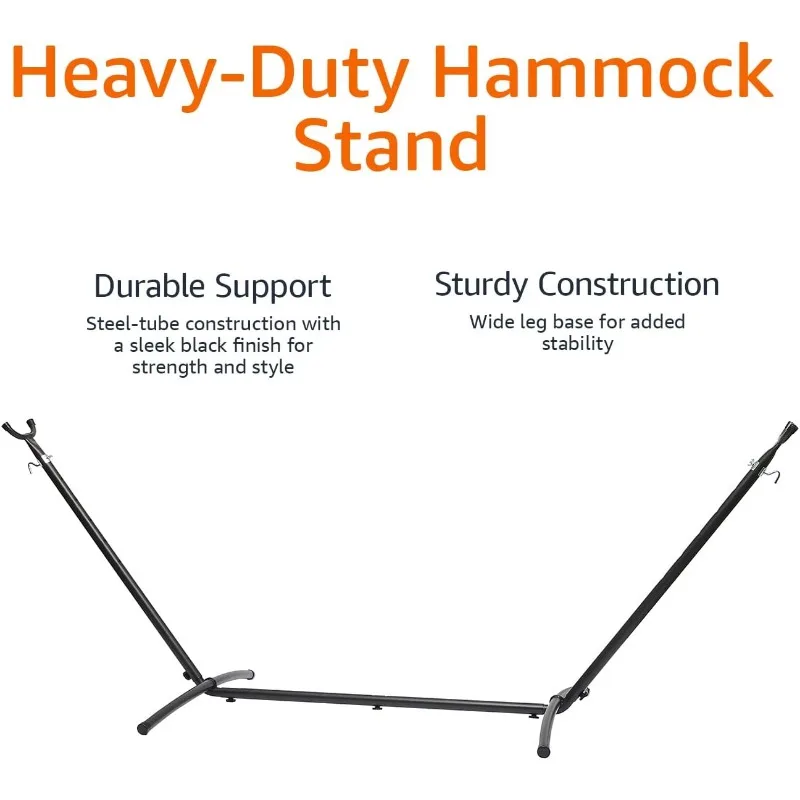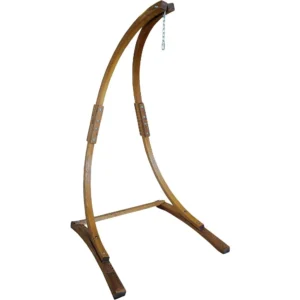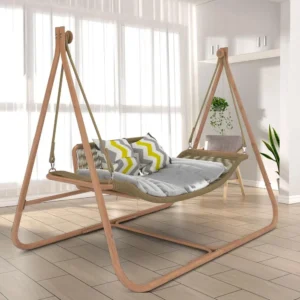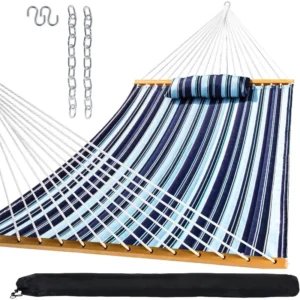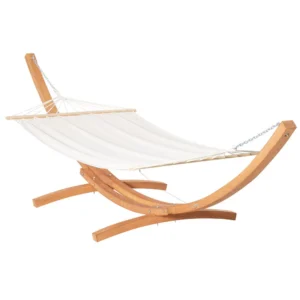Introduction: The Art and Science of Hammock Placement
Finding the perfect spot for your hammock is both an art and a science. An ideal hammock environment combines three essential elements: safety, comfort, and atmosphere. When these elements come together harmoniously, your hammock experience transforms from simply resting to truly relaxing.
The environment where you hang your hammock directly impacts your relaxation quality. Research suggests that proper relaxation environments can significantly reduce stress levels and improve overall well-being. As hammock popularity continues to grow—with sales increasing by double digits annually across various settings—understanding proper setup becomes increasingly important.
This comprehensive guide will explore everything you need to create your perfect hammock haven, including:
- Proper anchor points that ensure stability and safety
- Optimal positioning for maximum comfort
- Creating surroundings that enhance your relaxation experience
Whether you’re looking to create an outdoor retreat among the trees, an indoor sanctuary, or a specialized setup for adventures, understanding the differences between indoor and outdoor hammock placement will help you create your ideal relaxation space.
Essential Elements of the Perfect Hammock Setup
Before diving into specific environments, let’s establish the fundamental elements that make any hammock setup safe, comfortable, and enjoyable.
Safety Fundamentals
Safety should always be your top priority when setting up a hammock:
- Anchor integrity: Ensure your supports can hold at least 250-400 pounds (113-181 kg)
- Weight limits: Always check and respect the manufacturer’s recommended capacity
- Clearance requirements: Maintain at least 18 inches (45 cm) above the ground and away from hazards
The Physics of Comfort
The most comfortable hammock setup follows these guidelines:
- Hang angle: Aim for a 30-degree angle from horizontal at the anchor points
- Proper height: When seated, your hammock should be 18-24 inches (45-60 cm) from the ground
- Distance between anchors: Typically 10-15 feet (3-4.5 m) apart, depending on your hammock length
Environmental Considerations
The perfect hammock environment also requires:
- Level ground beneath your hammock
- Protection from harsh elements (excessive sun, wind, rain)
- Privacy and quiet for maximum relaxation
Understanding these basics is crucial before selecting your specific hammock location. For comprehensive safety requirements for proper hammock installation, you’ll want to consider both the equipment and environment together.
When selecting your setup, consider browsing high-quality hammocks with proper stands that are engineered to provide optimal support while maintaining perfect tension and positioning.
Outdoor Natural Settings: Finding Your Tree Paradise
Trees provide the classic natural anchors for hammocks, but not all trees are created equal. Here’s how to identify the perfect arboreal supports for your outdoor haven.
Selecting Suitable Trees
Look for these characteristics when choosing trees:
- Species: Hardwoods like oak, maple, and pine work best
- Health: Only use living, healthy trees without signs of disease or decay
- Diameter: Select trees at least 6 inches (15 cm) in diameter
- Stability: Ensure trees are firmly rooted with no signs of leaning
Proper Tree Positioning
The ideal tree setup includes:
- Distance: Trees spaced 10-15 feet (3-4.5 m) apart for standard hammocks
- Clearance: Open space between trees free from branches, roots, and hazards
- Ground condition: Level, well-drained area beneath your hanging spot
Tree Protection Techniques
Responsible hammock users always protect the trees they use:
- Use wide tree straps (minimum 1.5 inches/3.8 cm wide) to distribute pressure
- Never nail, screw, or permanently attach anything to trees
- Regularly rotate your hanging spots to prevent bark damage
- Remove your setup when not in use for extended periods
Understanding weather exposure considerations for hammocks left outdoors is essential for both equipment longevity and tree health. For outdoor adventures, explore specially designed camping hammocks with stands that provide versatility while minimizing environmental impact.
Alternative Outdoor Anchor Points: Beyond the Trees
When trees aren’t available or suitable, several excellent alternatives can provide the perfect hammock environment.
Built Structures for Hammock Support
Many existing outdoor structures can serve as ideal hammock supports:
- Posts: Wooden or metal posts set in concrete
- Pergolas and gazebos: Provide built-in anchor points and partial shade
- Beams: On covered patios or decks can support hammocks when properly reinforced
For permanent installations, knowing how deep wooden posts should be for hammock support ensures your setup will remain safe and stable for years.
Hammock Stands for Maximum Flexibility
Stands offer several advantages for outdoor hammock environments:
- Portability: Move your relaxation spot to follow shade or views
- No damage: Eliminate concern about tree health or property alteration
- Versatility: Use on beaches, lawns, or patios where natural anchors aren’t available
Popular outdoor stand options include:
- Portable metal stands (250-300 lbs/113-136 kg capacity)
- Wooden arc stands (300-450 lbs/136-204 kg capacity)
- Heavy-duty rope stands (400-500 lbs/181-227 kg capacity)
Each type requires different amounts of space, with wooden arc stands needing the most room (about 15 feet/4.5 m in length) but providing the most aesthetic appeal.
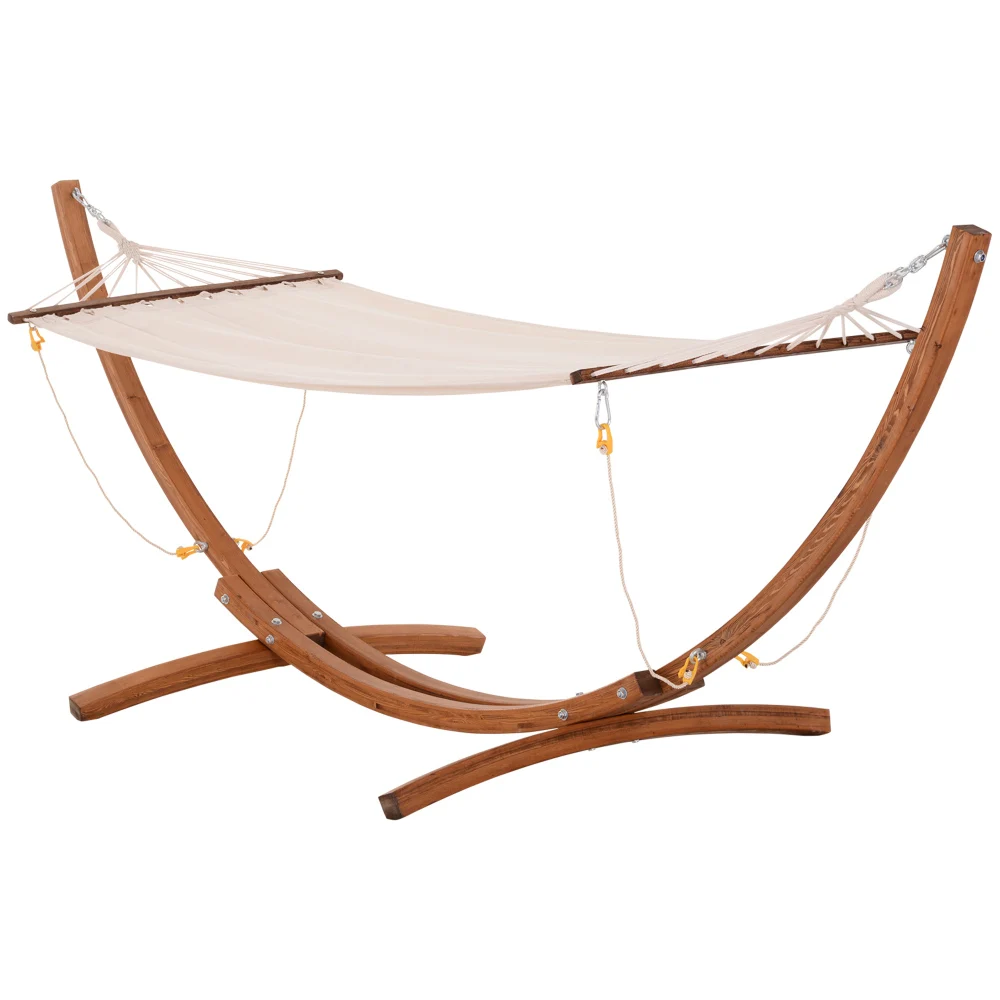
Perfecting Your Outdoor Hammock Environment
Once you’ve established safe anchor points, it’s time to perfect the surrounding environment for maximum enjoyment.
Strategic Sun and Shade Management
The ideal hammock spot balances sun exposure throughout the day:
- Morning sun provides gentle warmth without overheating
- Dappled afternoon shade prevents excessive heat and UV exposure
- Consider seasonal sun angles when planning permanent setups
- Position your hammock east-west for minimal direct facial sun exposure
Wind and Weather Protection
Create a comfortable microclimate by:
- Using natural windbreaks like shrubs, walls, or fences
- Positioning your hammock perpendicular to prevailing winds
- Considering nearby structures that might funnel or block breezes
- Having a quick-setup tarp or rainfly accessible for unexpected weather
Enhancing Natural Ambiance
The perfect outdoor hammock environment engages all senses:
- Sight: Position for the best views (water, mountains, garden, sky)
- Sound: Choose locations with pleasing natural sounds while minimizing noise pollution
- Smell: Plant aromatic herbs or flowers nearby (bonus: many repel insects)
- Touch: Create an inviting ground area with outdoor rugs or cushioned mats
For expert advice on selecting the perfect spots for hammock placement, consider factors like privacy, accessibility, and seasonal changes. To enhance your comfort, explore hammocks with built-in shade protection for the ultimate outdoor relaxation experience.
Indoor Hammock Retreats: Bringing Outdoor Relaxation Inside
Indoor hammocks create year-round relaxation sanctuaries regardless of weather or outdoor space limitations.
Assessing Indoor Spaces
Not every room works well for indoor hammocks. Look for:
- Sufficient size: Minimum room dimensions of 12 feet × 8 feet (3.6 m × 2.4 m) for standard hammocks
- Clearance space: At least 3-4 feet (0.9-1.2 m) on each side plus swing space
- Structural integrity: Rooms with accessible wall studs or ceiling joists
- Complementary purpose: Reading rooms, home offices, sunrooms, or bedroom corners
Space Planning for Indoor Hammocks
Successful indoor hammock environments require careful planning:
- Map swing path to avoid collisions with furniture or fixtures
- Consider the hammock’s role—centerpiece or secondary feature
- Plan for both active use and stowed positions if space is limited
- Account for entry and exit movement (you need more space than just the hammock itself)
Many homeowners wonder if it’s safe to hang a hammock indoors. With proper installation methods and weight considerations, indoor hammocks can be both safe and transformative. For smaller spaces or rooms where drilling isn’t possible, space-saving hammock chairs with stands offer a perfect alternative.

Secure Indoor Mounting: Tools, Techniques and Safety
Properly mounting a hammock indoors requires attention to structural elements and appropriate hardware.
Finding Structural Support
Never mount to drywall alone. Always secure to:
- Wall studs: Typically spaced 16 or 24 inches (40.6 or 61 cm) apart
- Ceiling joists: Follow the same spacing pattern as wall studs
- Exposed beams: Ensure they’re structural, not decorative
- Reinforced mounting points: Sometimes necessary for unusual layouts
Use a stud finder with deep scanning capability to locate the center of support beams.
Hardware Selection and Installation
Choose hardware based on your mounting situation:
- Eye bolts: 3/8-inch (1 cm) diameter minimum, lag-style for wood structures
- Mounting plates: Distribute weight across multiple fastening points
- Heavy-duty hooks: Look for closed designs rated for at least 300 pounds (136 kg)
The installation process requires:
- Locating and marking the center of studs or joists
- Pre-drilling appropriate sized pilot holes
- Installing mounting hardware with proper tools (socket wrench for eye bolts)
- Testing gradually with increasing weight before full use
For ongoing safety, regularly inspect your mounting hardware for signs of loosening or damage. Comprehensive safety guidelines for different hammock environments help ensure your setup remains secure year after year.
Indoor Hammock Stands: Flexibility Without Modification
For renters or those who prefer not to drill into walls, indoor hammock stands provide an excellent solution.
Benefits of Indoor Stands
Hammock stands offer distinct advantages for indoor environments:
- No structural modifications required
- Repositionable as needs or furniture arrangements change
- Often more visually integrated with home décor
- Can be moved from room to room as desired
Space Planning for Indoor Stands
Be realistic about space requirements:
- Standard hammock stands need 8-12 feet (2.4-3.6 m) in length
- Width requirements of 4-5 feet (1.2-1.5 m) for stability
- Allow additional clearance for entry/exit and gentle swinging
- Consider collapsible or space-saving designs for smaller rooms
Selecting the Right Indoor Stand
The perfect indoor stand balances function and aesthetics:
- Material: Wood offers warmth and natural beauty; metal provides modern appeal
- Design: Some stands become statement furniture pieces
- Assembly: Consider ease of assembly/disassembly if seasonal storage is planned
- Stability: Heavier stands provide more stability but less portability
For maximum flexibility, explore portable hammock stands that can transition between indoor and outdoor use as your needs change throughout the year.
Creating a Cozy Indoor Hammock Sanctuary
Transform your indoor hammock space into a dedicated relaxation zone with these enhancement strategies.
Comfort Enhancements
Make your hammock irresistibly cozy:
- Layer with soft blankets that can be easily adjusted
- Add specialized hammock pillows that stay in place during movement
- Position a small side table within reach for books, devices, or beverages
- Include a basket nearby for storing comfort items when not in use
Atmosphere Creation
The right ambiance transforms a hammock into a sanctuary:
- Lighting: Use adjustable, warm lighting (string lights, floor lamps with dimmers)
- Sound: Consider sound-absorbing elements for better acoustics
- Texture: Incorporate soft textiles that contrast with the hammock material
- Scent: Add natural aromatherapy with plants or essential oil diffusers
Functional Design
Make your hammock space serve multiple purposes:
- Position for viewing entertainment if desired
- Create a dedicated reading nook with proper lighting
- Design a meditation or mindfulness space with minimal distractions
- Set up a productivity swing for creative thinking
For inspiration on specific recommendations for indoor hammock placement, consider room function, traffic flow, and how the space will be used throughout different times of day.
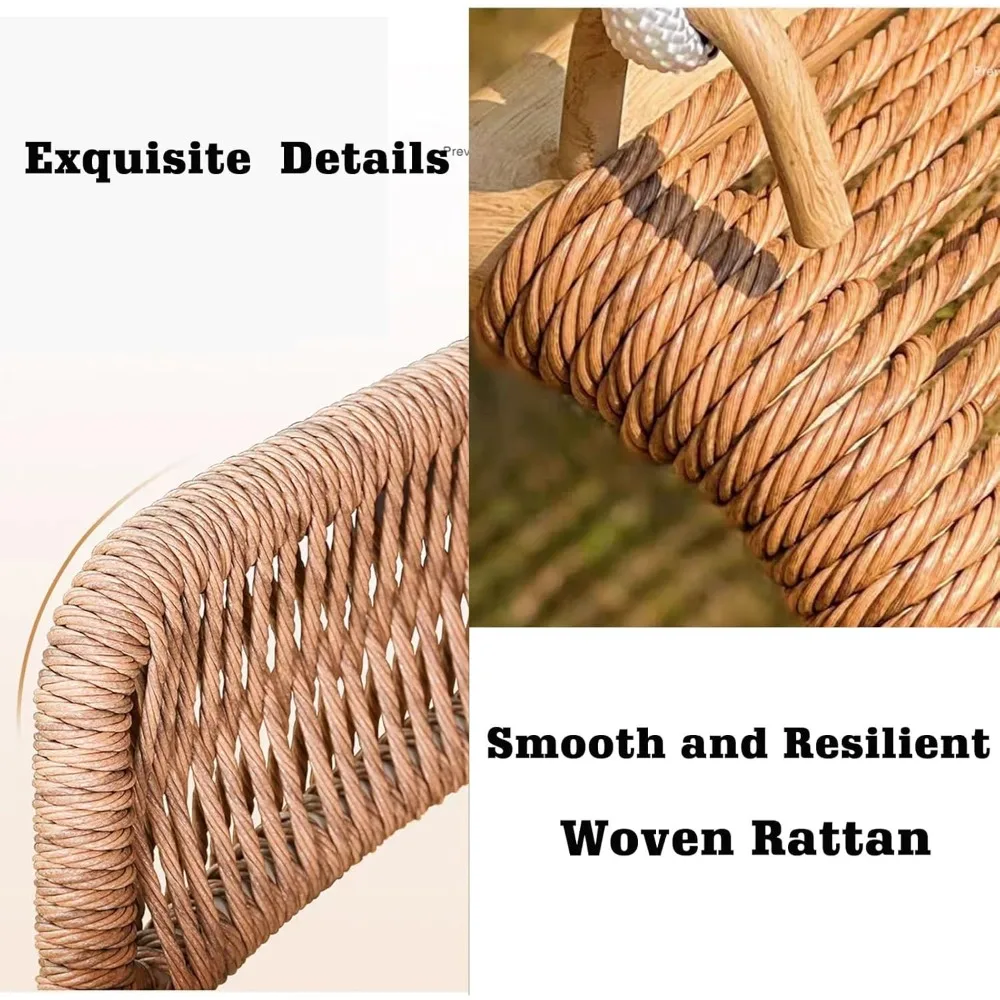
Dark Wood Hammock Sets, Porch Swing Chair Sets
$653.82 Select options This product has multiple variants. The options may be chosen on the product pageA-Frame Stand Hammock Sets, Swinging Hammock Chair Sets
$154.62 Select options This product has multiple variants. The options may be chosen on the product pageCamping Hammock Sets with Bug Net, Ultralight Camping Hammock Sets
$139.72 Select options This product has multiple variants. The options may be chosen on the product pageLight Wood Hammock Sets, Swinging Hammock Chair Sets
$1,359.35 Select options This product has multiple variants. The options may be chosen on the product pageClassic Wooden Stand Hammock Sets, Heavy Duty Hammock Sets
$1,061.68 Select options This product has multiple variants. The options may be chosen on the product page
Specialized Hammock Environments: Camping and Adventures
Hammock camping requires special consideration for both comfort and safety in natural settings.
Site Selection for Hammock Camping
The perfect hammock campsite features:
- Trees or supports spaced 10-15 feet (3-4.5 m) apart
- Protection from prevailing winds
- Good drainage in case of rain
- Natural overhead protection when possible
- Safe distance from dead branches or hazardous trees
Weather Protection Systems
Unlike backyard hammocking, camping requires additional protection:
- Rain tarps: Set up with proper ridgelines and adequate pitch
- Underquilts: Essential for preventing “cold butt syndrome” when temperatures drop
- Bug nets: Critical in insect-heavy environments
- Top quilts: More efficient than sleeping bags in hammocks
Environmental Responsibility
Practice Leave No Trace principles:
- Use tree-friendly straps at least 1.5 inches (3.8 cm) wide
- Set up in established areas when possible
- Avoid damaging vegetation when creating your site
- Pack out all trash and equipment
For comprehensive camping systems, consider specialized hammock setups for camping with insect protection that integrate all the necessary components for overnight comfort and safety.
Urban Hammocking: Finding Your City Oasis
Limited space doesn’t mean limited relaxation. Urban environments offer unique opportunities for hammock enjoyment.
Maximizing Small Outdoor Spaces
Make the most of urban outdoor areas:
- Balconies: Use specialized stands or wall-mounted brackets
- Patios: Consider combination furniture/hammock stands
- Rooftops: Create wind protection and ensure structural support
- Courtyards: Use temporary stands that can be stored when not in use
Urban Hammock Etiquette
Be a good neighbor with your urban hammock:
- Check building regulations before installation
- Be mindful of sight lines and privacy concerns
- Consider noise impact when using or moving your hammock
- Be aware of weight limits on balconies and elevated structures
Space-Saving Solutions
Creative approaches for urban hammock environments:
- Chair hammocks require far less space than full-length options
- Foldable or collapsible stands can be stored when not in use
- Wall-mounted brackets with removable hammocks maximize floor space
- Multi-purpose hammock furniture serves additional functions
For more tips on finding the right spot in limited urban spaces, consider vertical opportunities and multi-functional approaches that make hammocks practical even in the most compact living situations.
Troubleshooting Common Hammock Environment Challenges
Even with careful planning, hammock setups sometimes need adjustment. Here’s how to address common issues:
Finding the Perfect Sag
If your hammock is uncomfortable:
- Too much sag: Tighten end straps or move anchor points closer together
- Too tight: Loosen end straps or move anchor points further apart
- Ideal curve: Aim for a 30-degree angle from the anchor points
Dealing with Limited Space
When your ideal space is too small:
- Consider shorter hammocks designed for compact spaces
- Try diagonal hanging to maximize available length
- Use hammock chairs instead of full-length models
- Look for wall-mounted solutions with minimal footprint
Managing Weather Challenges
For outdoor setups facing weather issues:
- Install quick-release systems for fast setup/takedown during weather changes
- Use waterproof materials for hammock protection
- Create seasonal setups that adapt to changing conditions
- Consider retractable awnings or shade sails for semi-permanent protection
Handling Body Position Discomfort
If you’re not comfortable in your hammock:
- Try lying at a diagonal angle (10-15 degrees off center)
- Add a structural ridgeline to maintain consistent sag
- Experiment with different pillow arrangements
- Consider a spreader bar design if you prefer a flatter lay
Frequently Asked Questions
What is the optimal distance between hammock anchor points?
The ideal distance is typically 10-15 feet (3-4.5 m) for standard hammocks. Measure your hammock’s total length and add 2-3 feet (0.6-0.9 m) to find your optimal distance. Adjustable straps can help fine-tune the spacing.
How can I verify if my anchor points can support enough weight?
For trees, ensure they’re at least 6 inches (15 cm) in diameter and healthy. For indoor mounting, always attach to studs or joists. Hardware should specify weight ratings—look for at least 300 pounds (136 kg) capacity per anchor point, which is double the typical user weight for safety margin.
Are single-point hammock hangers safe?
Single-point hangers (for hammock chairs or swings) must be installed into solid structural elements and use hardware rated for dynamic loads. These typically require stronger mounting than two-point systems since all weight concentrates at one point.
How do I protect trees when hanging my hammock?
Always use wide straps (at least 1.5 inches/3.8 cm wide), never ropes or wire. Remove your hammock when not in use for extended periods. Rotate your hammock locations to prevent long-term bark damage.
What’s the biggest difference between indoor and outdoor hammocks?
Beyond weather resistance, understanding the differences between indoor and outdoor hammocks involves material durability, structural design, and specialized features. Indoor hammocks often prioritize comfort and aesthetics, while outdoor models focus on durability and weather resistance.
Conclusion: Your Perfect Hammock Environment Awaits
Creating your ideal hammock environment combines practical considerations with personal preferences. Whether you choose a natural setting among the trees, a cozy indoor retreat, or a portable adventure setup, the perfect hammock haven follows the same principles: secure anchor points, optimal positioning, and thoughtful surroundings.
Remember that safety provides the foundation for relaxation—never compromise on secure mounting or appropriate weight limits. From there, personalize your space to reflect your unique relaxation style, whether that means a minimalist approach or a fully accessorized comfort zone.
The transformative power of a well-designed hammock environment extends beyond simple rest. It creates a personal sanctuary that can become your favorite space for reading, thinking, connecting with nature, or simply being. Your perfect hammock haven awaits—it’s time to create it!

